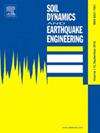A PSHA for Mexico City based solely in Fourier-based GMM of the response spectra
IF 4.2
2区 工程技术
Q1 ENGINEERING, GEOLOGICAL
引用次数: 0
Abstract
A key component of any probabilistic seismic hazard analysis (PSHA) is the capability of predicting ground motion intensities for future earthquakes with different characteristics and occurrence frequencies. Ground motion models (GMMs) have been the preferred tools to predict, in a probabilistic manner, the size of the ground motion as a function of the earthquake's rupture parameters (i.e., location, depth, orientation of the rupture plane, rupture area, and rupture shape, among others). For this purpose, two different approaches have been used in PSHA practice. The first one, widely used and with hundreds of available models, are semi-empirical derivations of GMMs for response spectral values. The second one, which is less used in professional practice, requires the development of the predicting model for the Fourier amplitude spectrum (FAS) and the duration of the strong motion, to convert them into response spectral values through random vibration theory (RVT). The second approach, although computationally complex, should be preferred when site-effects are considered in the PSHA since these can be incorporated in a more efficient and theoretically correct way. Also, this second approach allows estimating hazard levels for different damping ratios and other hazard intensity measures such as peak ground velocity (PGV) and peak ground displacement (PGD) straightforward. This paper shows the methodology and results of a PSHA for Mexico City, a place with well-known existence and relevance of site-effects, carried out exclusively using Fourier-based GMMs, developed to be representative for the different types of earthquakes that contribute to earthquake hazard in the city (i.e., interface, intraslab, and crustal). The strategy to estimate ground motions in Mexico City consists in obtaining FAS-based ground motion models for a reference firm ground station and multiplying the computed FAS by an empirical transfer function that describes the frequency-dependent amplification factors between the reference station and the soft site of interest.
完全基于傅里叶响应谱 GMM 的墨西哥城 PSHA 系统
任何概率地震灾害分析(PSHA)的一个关键组成部分都是能够预测具有不同特征和发生频率的未来地震的地动强度。地震动模型(GMM)是以概率方式预测地震动大小的首选工具,它是地震破裂参数(即位置、深度、破裂面方向、破裂面积和破裂形状等)的函数。为此,在 PSHA 实践中使用了两种不同的方法。第一种方法应用广泛,有数百种可用模型,是响应谱值 GMM 的半经验推导。第二种方法在专业实践中使用较少,需要开发傅立叶振幅谱(FAS)和强运动持续时间的预测模型,通过随机振动理论(RVT)将其转换为响应谱值。第二种方法虽然计算复杂,但在 PSHA 中考虑场地效应时应优先采用,因为可以以更有效和理论上更正确的方式纳入这些效应。此外,第二种方法还可以直接估算不同阻尼比和其他危险强度指标(如峰值地表速度 (PGV) 和峰值地表位移 (PGD))的危险等级。本文展示了墨西哥城 PSHA 的方法和结果,墨西哥城是一个众所周知存在场地效应且与场地效应相关的地方,PSHA 完全采用基于傅立叶的 GMM,其开发目的是代表造成墨西哥城地震灾害的不同地震类型(即界面地震、台内地震和地壳地震)。估算墨西哥城地动的策略包括:为一个基准坚固地面站获取基于 FAS 的地动模型,并将计算出的 FAS 乘以一个经验传递函数,该函数描述了基准站和相关软地点之间随频率变化的放大系数。
本文章由计算机程序翻译,如有差异,请以英文原文为准。
求助全文
约1分钟内获得全文
求助全文
来源期刊

Soil Dynamics and Earthquake Engineering
工程技术-地球科学综合
CiteScore
7.50
自引率
15.00%
发文量
446
审稿时长
8 months
期刊介绍:
The journal aims to encourage and enhance the role of mechanics and other disciplines as they relate to earthquake engineering by providing opportunities for the publication of the work of applied mathematicians, engineers and other applied scientists involved in solving problems closely related to the field of earthquake engineering and geotechnical earthquake engineering.
Emphasis is placed on new concepts and techniques, but case histories will also be published if they enhance the presentation and understanding of new technical concepts.
 求助内容:
求助内容: 应助结果提醒方式:
应助结果提醒方式:


